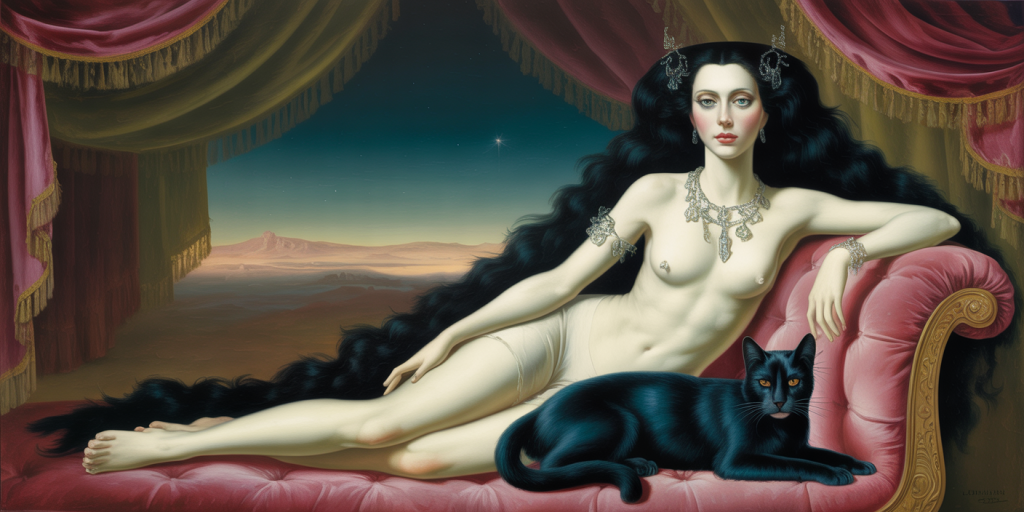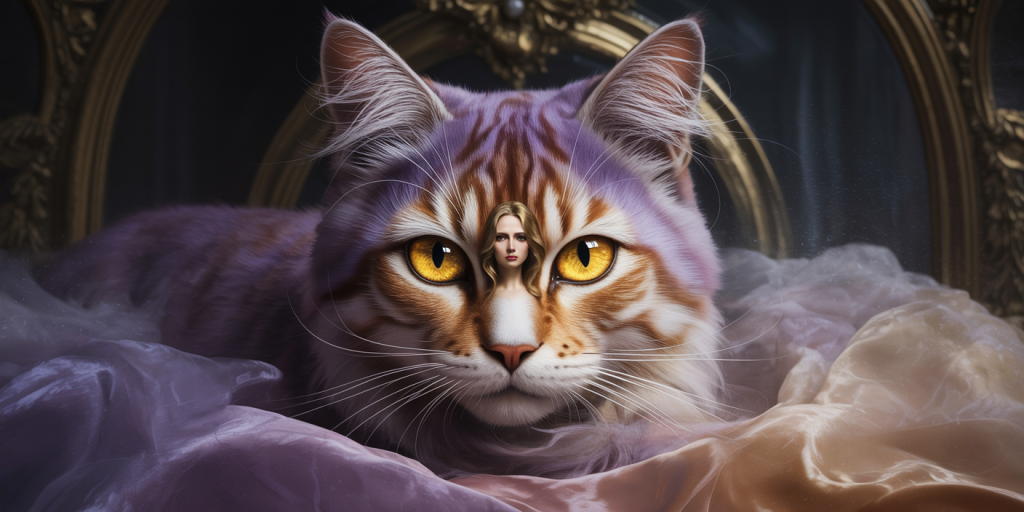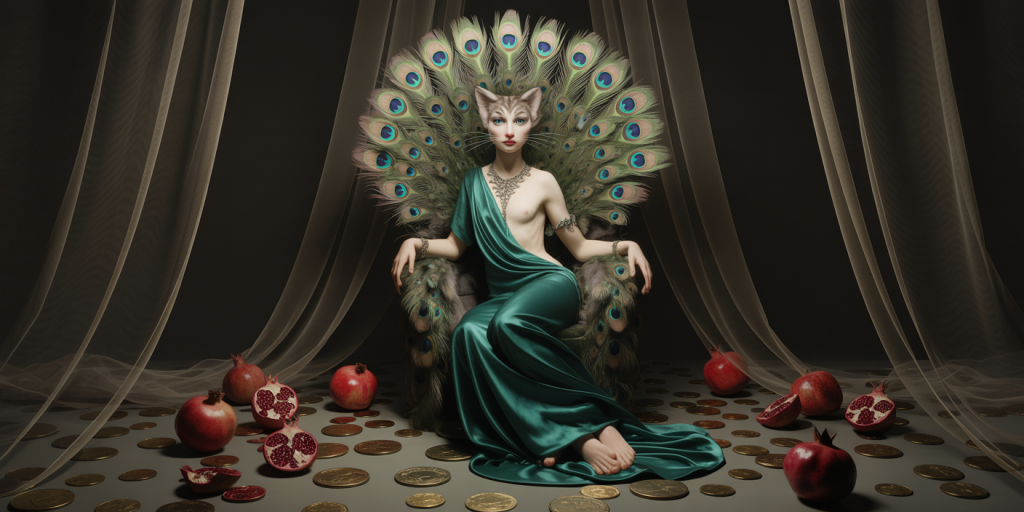Leonor Fini and the Cat as Goddess of DeliriumLeonor Fini e o Gato Como Deusa do Delírio
In the realm of Leonor Fini, the feline is no simple companion. It is priestess, oracle, seductress. A creature not of the domestic, but of the divine. Her cats curl in twilight, blink in riddles, and step across velvet dreams like sovereigns of the subconscious. To watch one of her works is to feel the fur of mystery brush against the edge of knowing. Their silence speaks, their posture prophesies.
Fini did not paint cats—she conjured them. And in their languid limbs and golden glances, we find the spirit of a world that resists cages. The cat becomes a mirror of the feminine psyche: unyielding, enchanting, wild in stillness. She kneads the canvas with claws of metaphor, transforming the feline into a goddess of delirium, poised forever between sleep and spell.
Table of Contents
- The Feline as Enchantress
- Whiskers that Write Prophecy
- Eyes of Ancient Fire
- The Lair of Velvet Dreams
- Feminine Sovereignty in Fur
- When Fur Becomes Aura
- Claws Hidden in Silk
- The Body as Temple of the Unsaid
- Dusk Lit by Pupil and Gaze
- Licking the Border of the Sacred
- The Dream Reclines with a Tail
- Colors That Smell Like Skin
- The Theater of Reclining Queens
- Silence Draped in Satin
- The Ritual of Watching
- Feathers, Fur, and Forbidden Fruit
- The Divine Nap
- Between Purr and Spell
- Textures of Reverie
- The Throne Built of Instinct
The Feline as Enchantress
Fini’s cats do not purr for comfort. They enchant. They curl like question marks into compositions that dare us to feel beyond the painted skin. Their presence is neither passive nor decorative. They cast spells. They set the tempo of the tableau.
Whiskers that Write Prophecy
Each whisker in her art feels deliberate, like a script etched in air. These are not mere details—they are symbols. The whiskers write across shadow, trace the ether, translate the unspoken. They act as antennae of otherworldly intent.

Eyes of Ancient Fire
The cat’s gaze in Fini’s world is not playful—it is mythic. It sees through centuries. The pupils stretch vertically like slits in reality. They do not observe; they judge, they awaken. They carry fire older than language.
The Lair of Velvet Dreams
Each environment around her cats is lush, shrouded in softness. Velvet, satin, layered fabrics become more than material—they are stages for dreams. The lair is not a room, but a state of mind, where fantasy breathes against the skin.
Feminine Sovereignty in Fur
The cat is the double of the woman, the extension of her unspoken empire. Both inhabit their space without apology. The woman does not own the cat; they reign together. Each fur-lined limb echoes a silent decree of power.
When Fur Becomes Aura
Fur in Fini’s work radiates. It blurs into smoke, into light. The boundary between cat and air dissolves. The creature becomes part vision, part memory. Texture is no longer tactile—it is emotion, perfume, incantation.
Claws Hidden in Silk
Danger is never far. Fini paints softness with the whisper of a warning. The claws are retracted, but not absent. Beneath the silk lies the sharpness of instinct. The cat, like the feminine, conceals its edge in grace.
The Body as Temple of the Unsaid
Fini’s female figures, draped or bare, do not pose—they dwell. Their bodies are temples where the unsaid resides. The cat rests beside them like a shrine guardian. Both speak in gazes and gestures. Words would diminish them.
Dusk Lit by Pupil and Gaze
Her scenes often take place in timeless light—twilight, candle-glow, or an eternal dusk. The cat’s eyes reflect this radiance, becoming twin moons. In the hush of shadow, it is their stare that lights the myth.

Licking the Border of the Sacred
Fini’s cats often touch or nestle against female forms with ritualistic intimacy. A tongue on a wrist. A tail across the chest. These gestures are not random—they mark transitions. They trace borders between flesh and myth, pleasure and possession.
The Dream Reclines with a Tail
Sleep, in her work, is not escape but trance. The reclining woman becomes dream, and the cat her guardian. Together, they float on silken beds that resemble clouds or altars. Rest becomes rite. The tail curves like a question inside a spell.
Colors That Smell Like Skin
Her palette is intimate. Creams, blushes, browns that echo the pulse of skin. They warm the eye, seduce the sense of scent. Color does not fill space, it breathes into it. The tones feel inhaled, not just seen.
The Theater of Reclining Queens
Fini composes her spaces like opera sets. Drapes cascade. Pillows swell. Everything is exaggerated, sensuous. The woman is not passive—she is queen. The cat at her feet is not pet, but consort. The throne is a bed, a stage, a sanctuary.
Silence Draped in Satin
Sound seems to vanish from her canvases. There is no echo, only hush. And yet, this silence is not empty. It is filled with tension, with secrets. Draped figures and lounging cats communicate with an intensity deeper than dialogue.
The Ritual of Watching
To watch is a sacred act in Fini’s world. Cats watch. Women watch. The viewer watches. Layers of gaze fold like veils. Watching is not passive—it is communion. Each stare is an invitation to abandon reason.
Feathers, Fur, and Forbidden Fruit
She often surrounds her figures with feathers, fruits, and felines—symbols of sensuality, knowledge, and power. The cat navigates these with indifference, as if to say: I have tasted all of it. I remain unchanged. I remain divine.
The Divine Nap
Fini elevates sleep to ritual. Her cats nap like sphinxes. Their stillness is sacred, their slumber oracular. Sleep is a trance, not rest. The goddess of delirium dreams with eyes half open.
Between Purr and Spell
A purr is not sound. It is spell. Fini paints the moment just before movement—when the tail flicks, when the spell deepens. The cat hums in silence. The spell is already cast.

Textures of Reverie
Each brushstroke in Fini’s world is velveted. Textures do not exist merely to be touched, but to evoke memory. A pillow recalls a scent. A fur evokes a lullaby. Her textures are not surface—they are nostalgia embodied.
The Throne Built of Instinct
The cat sits atop cushions, veils, thrones, and yet remains untamed. It is crowned by stillness, not dominance. In Fini’s world, instinct rules. The cat, as goddess, reigns not with power, but with presence. The throne is not built—it is claimed.
FAQ
Who was Leonor Fini?
Leonor Fini (1907–1996) was an Argentine-Italian surrealist painter known for her dreamlike imagery, powerful depictions of women, and recurring use of feline symbolism. She resisted classification, preferring sensuality and myth to dogma.
Why are cats so central to Fini’s work?
Cats symbolize mystery, autonomy, feminine power, and transformation. For Fini, they were companions, metaphors, and muses—beings that inhabited the liminal spaces between magic and matter.
What artistic style did Fini belong to?
Though associated with Surrealism, Fini maintained independence from any movement. Her work blends symbolism, dream logic, baroque theatricality, and erotic mythology.
How did she represent femininity?
Fini portrayed women as sovereign beings—goddesses, witches, oracles. Her art rejects passive depictions in favor of mysterious, sensual, and commanding figures often accompanied by cats.
What mediums did she use?
Fini painted primarily in oils, often on canvas or board. Her surfaces are richly textured, with an emphasis on theatrical detail and symbolic composition.
Final Reflections: The Tail that Writes the Spell
In Leonor Fini’s universe, the cat is no mere motif. It is altar, amulet, sovereign. It breathes myth and purrs prophecy. Each painting is not a scene but a temple, where fur meets gaze, and sleep touches the threshold of ecstasy.
The goddess of delirium wears whiskers. She walks silently across silk. She stares not to be adored, but to awaken. And in her presence, we remember that magic is not noise. It is the curl of a tail before it disappears into dream.
